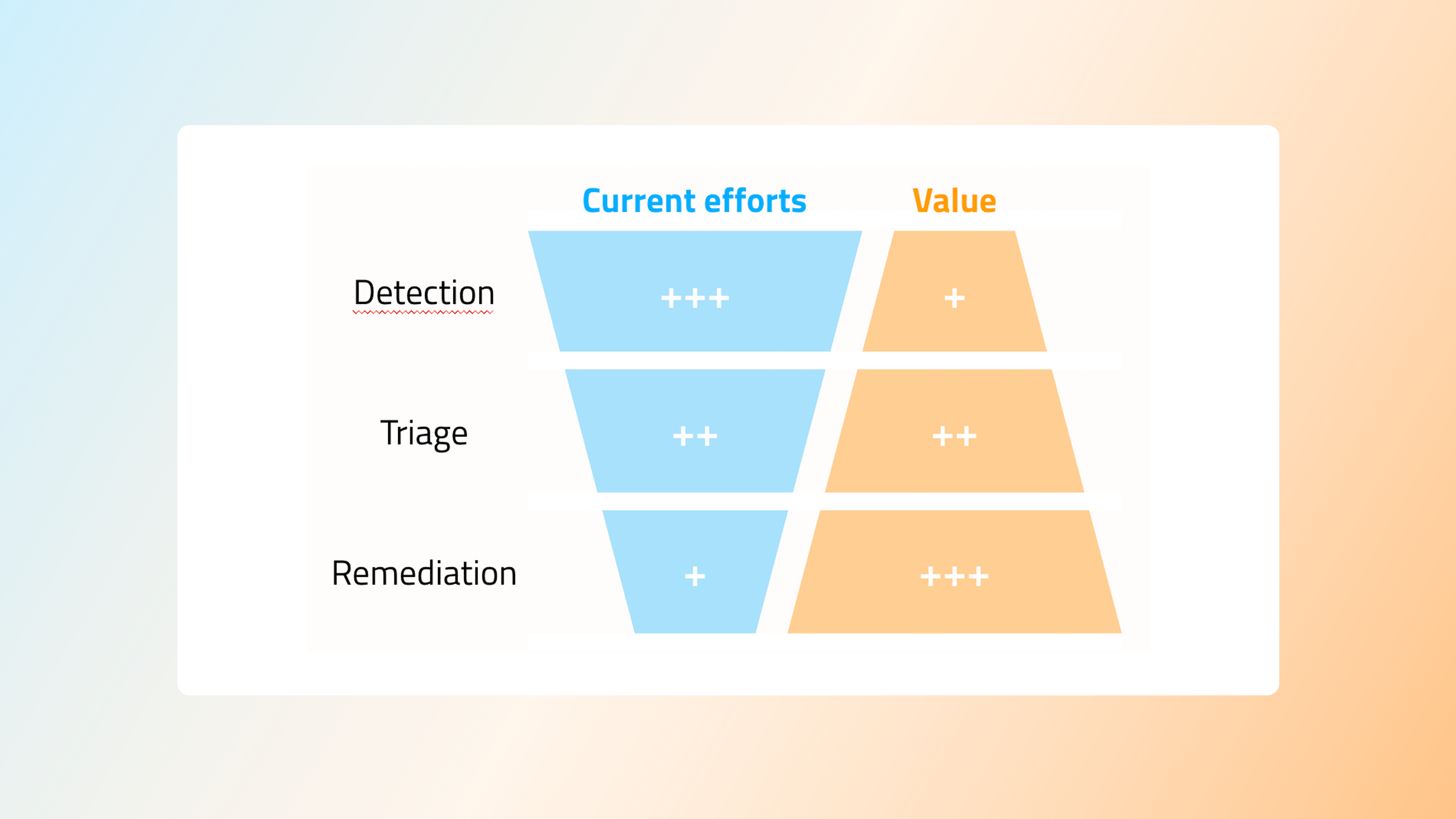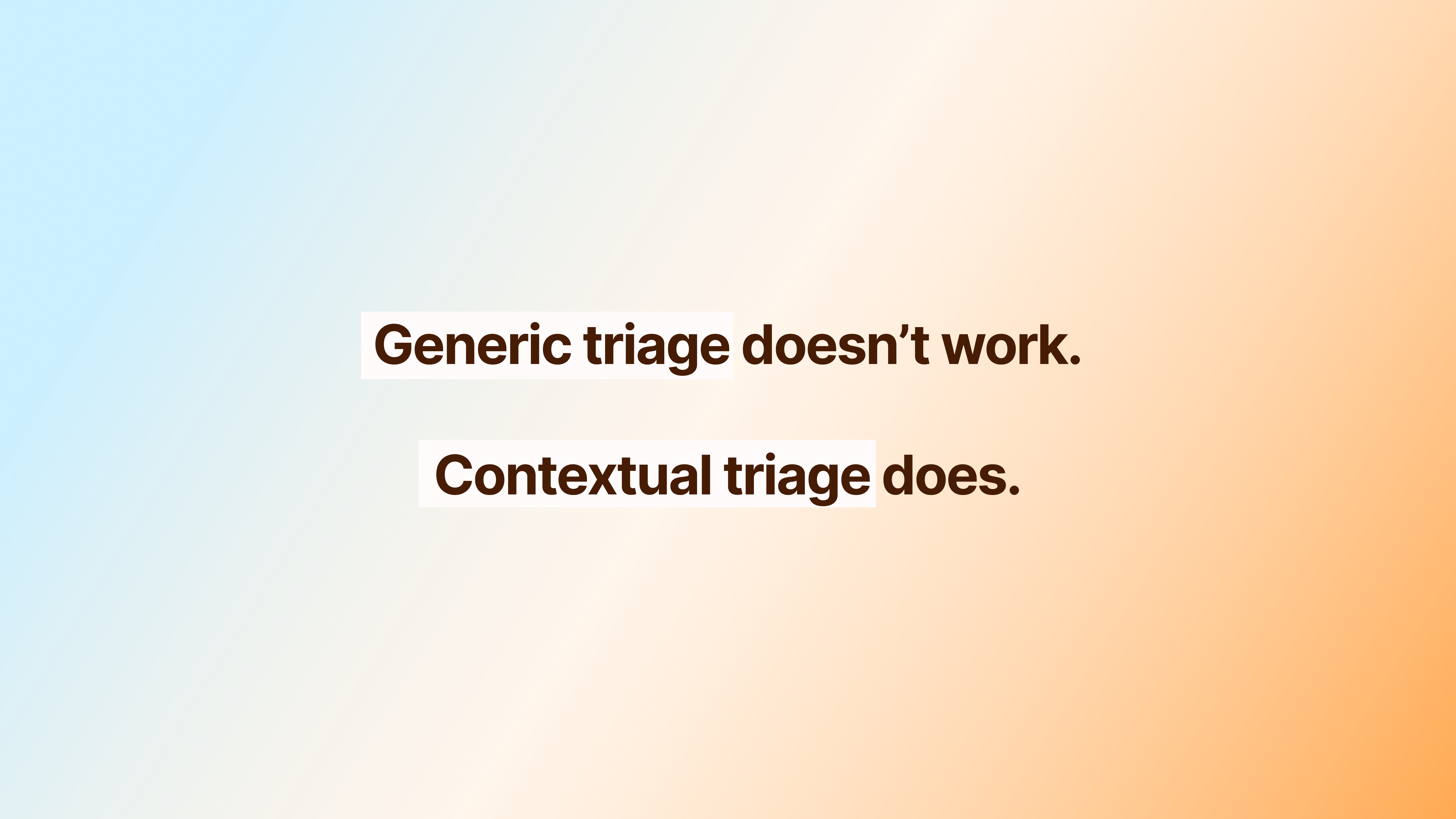
Stop Being Alert-Centric. Start Being Remediation-Centric.

Security must help, not hinder, software velocity.
That’s one of our core beliefs at Glev — a conviction forged through hundreds of conversations with AppSec leaders, developers, and security engineers on the ground. What we’ve consistently heard is this: teams are drowning in alerts, but starved for actionable remediation.
Today, many organizations still focus their AppSec efforts on detection — surfacing as many potential issues as possible. But in doing so, they create overwhelming noise and lose the battle where it really matters: fixing the right problems, fast.
It's time to shift. From alert-centric. To remediation-centric.
1. Detection is Easy. Remediation is the Bottleneck.
We often hear this phrase:
“We find problems faster than we fix them.”
And it’s true. Discovering issues is no longer the hard part.
In the past, visibility in application security was a real challenge. Code security lagged behind network and endpoint security. But that’s changed. Over the last decade, AppSec tooling has exploded. Open-source scanners have matured. Major players like Google are even open-sourcing powerful tools like OSV. If you want to find issues, you have more than enough options.
But once you've surfaced them… what next?
That’s where most AppSec programs break down. Developers are already under pressure. AppSec teams are stretched thin. Issues pile up in backlogs with vague descriptions and no clear path to fix.
Detection has scaled. Remediation hasn’t.
To close that gap, teams need remediation workflows that reduce friction — workflows that:
- Prioritize what matters most
- Offer clear, contextual guidance
- Fit developer velocity and tooling
2. Prioritization Is the First Step to Meaningful Remediation
One of the biggest challenges we hear from engineering teams is alert fatigue:
“We don’t know where to start.”
“Everything feels critical, so nothing gets fixed.”
In reality, less than 5% of alerts represent real, urgent risk — such as known exploited vulnerabilities, secret leaks, or reachable critical flaws. Yet teams waste precious cycles sifting through the noise.
This problem is only going to get worse as development accelerates. With AI-assisted coding, Copilots, and faster iteration cycles, more code means more issues — and more noise, unless you prioritize smartly.
Prioritization must go beyond severity scores. It should be rooted in real context, such as:
- Reachability (is the code path actually executable?)
- Exploitability (is there an active threat?)
- Business impact (is it tied to sensitive data or critical flows?)
- Environmental context (is it in prod? exposed externally?)
- Dependency mapping (how deep is the issue buried?)
At Glev, we enrich every alert with this kind of internal and external context to cut through the noise. The goal: help teams focus developer time on the few issues that matter most, not the many that don’t.
3. Remediation Builds Security Muscle Memory
Shifting to a remediation-centric model isn’t just about fixing faster — but fixing smarter, and in a way that builds capability over time.
First, it’s about reducing the time to fix. Most developers are not security experts. When they face a vulnerability, a lot of time is spent just trying to understand:
- Why is this a risk?
- How can I fix it?
- What’s the safest and most efficient remediation path?
Without the right context, this investigation can take hours — and often leads to trial and error or stalled tickets.
That’s why at Glev, we enrich each issue with clear, context-aware remediation guidance. By understanding the environment, the usage, and the business criticality, we surface not just the problem, but the best way to solve it — quickly, accurately, and with confidence.
But the benefits go further than efficiency.
Every time you help a developer fix an issue the right way, you're also helping them understand the underlying pattern. Over time, this leads to fewer recurring vulnerabilities, more secure code at the source, and a security-aware engineering culture.
And for this to truly work, remediation must be deeply integrated into how developers already operate. Security guidance should:
- Respect sprint cycles, ticketing systems, and delivery cadences
- Be surfaced inside familiar tools (IDEs, Git, CI/CD pipelines)
- Avoid imposing new processes or breaking dev flow
In short: if you want developers to fix, meet them where they work, not where security wants them to go.
4. How Glev Helps You Become Remediation-Centric
At Glev, we’re building your AI AppSec partner — one that helps you move from signal overload to secure outcomes.
Here’s how we help you make that shift:
- Surface real issues, not just raw alerts, using contextual filtering and reachability analysis
- Prioritize by business risk, not just CVSS scores
- Guide remediation with AI-generated fixes, code-aware suggestions, and actionable documentation
- Integrate with your stack, so developers never need to leave their workflows or tools
- Learn over time, building an institutional AppSec memory that is unique to your organization
That last point is key: remediation is also a source of knowledge capital. With every fix, Glev captures:
- The functions and patterns you use
- The decisions your teams made
- The remediations that worked best in your context
- The feedback developers gave on what helped or didn’t
Over time, this becomes a unique and evolving AppSec brain — one that helps you fix faster, onboard new devs more securely, and avoid past mistakes.
The result? Less noise. Smarter remediation. And security that scales with your development.
It’s Time to Make the Shift
The best AppSec programs don’t measure success by how many alerts they find.
They measure it by how many real risks they fix.
Being remediation-centric means you’re not just reacting to threats — you’re building lasting security into the way you develop software.
It’s the only way to scale AppSec without slowing down innovation.

